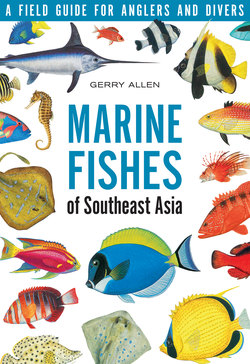Читать книгу Marine Fishes of South-East Asia - Gerry Allen - Страница 13
На сайте Литреса книга снята с продажи.
ОглавлениеECOLOGY OF
REEF FISHES
The majority of fishes included in this book are generally considered to be inhabitants of coral reefs. However, reefs are highly complex systems, consisting of numerous microhabitats. In general, coral reef fishes are finely synchronised to their environment.
Each species exhibits very precise habitat preferences that are dictated by a combination of factors including the availability of food and shelter, and various physical parameters such as depth, water clarity, currents, and wave action. The huge number of species found on coral reefs is a direct reflection of the high number of habitat opportunities afforded by this environment.
Coral reef fishes generally exhibit a higher degree of habitat partitioning than do fishes from cooler seas. A good example of the fine scale on which this principle operates is the Urchin Clingfish (Pl. 12-6). It is usually found amongst the spines of Diadema sea urchins or nearby branching corals and feeds primarily on the tube feet of its host urchin or on coral- burrowing molluscs. The coral reef offers numerous examples of fishes that have similar narrow habitat and feeding requirements. Water depth is also an important partitioning factor, and again there are numerous examples of coral reef fishes that have well defined depth ranges. In the very broadest sense there are three main depth categories for reef fishes: shallow (0-4 m), intermediate (5-19 m), and deep (20 m+). The depth limits of these zones may locally vary depending largely on the degree of shelter and sea conditions. The shallow environment is typified by wave action which in highly protected areas such as coastal bays or lagoons may exert its effect down to only a few cm. On the contrary in exposed outer reef structures the effect of surface waves may sometimes be felt below 10 m. The intermediate zone harbours the greatest abundance of fishes and live corals. Here wave action is minimal, although currents are often strong, and sunlight is optimal for reef-building corals. The deep outer reef slope is characterised by reduced light levels, hence fewer corals and fishes. Although species numbers are reduced the species that occur in this habitat are among the most interesting of coral reef fishes. A high percentage of the new fishes that have been discovered on coral reefs in the past three decades were collected on deep reefs by SCUBA diving scientists.
The region’s reef environments can be broadly classified into two major categories: sheltered inshore reefs or lagoons and outer reefs. Under optimum conditions both of these environments can support extensive beds of nearly 100 per cent coral cover. Inshore or coastal reefs may be strongly influenced by freshwater runoff and resultant siltation. Underwater visibility on these reefs is often greatly reduced, particularly during the wet season when rivers are flowing at their maximum. Coastal reefs and lagoons are further characterised by extensive sand or silt bottom areas that may support broad seagrass beds. In most coastal reef or lagoon situations the maximum depth seldom exceeds 25 m and due to heavy siltation coral growth is usually sparse below 15 m depth.
Outer reefs often have a classical reef structure consisting of a broad shallow reef flat, a raised algal ridge, reef front zone of surge channels, and a steep outer slope. But on some islands the bottom plunges into the depths directly from the rocky shore. The clearest waters are found on outer reef slopes and underwater visibility may sometimes exceed 30 m. Coral growth is most abundant between about 5 and 15 m depth, although in some areas appreciable growth may extend well below this limit. In shallower water corals are inhibited by the pounding surge, and in deeper water by the much reduced penetration of light. Although most reef-building corals do not thrive below 30-40 m, certain reef fishes may penetrate well below these depths. Observations made in research submarines at Hawaii and Enewetak Atoll indicate that reef species, including some damselfishes, butterflyfishes, and squirrelfishes, may occur to depths approaching 200 m.
A perfect day on Australia’s Great Barrier Reef. (R. Steene)
